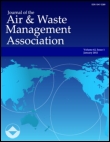 Exposure to airborne ultrafine particles from cooking in Portuguese homes” é um artigo publicado no Journal of the Air & Waste Management Association (Taylor & Francis) e que teve a contribuição de Paula Albuquerque, docente da área científica de Saúde Ambiental da Escola Superior de Tecnologia da Saúde de Lisboa (ESTeSL) e que contou igualmente com o contributo de docentes e investigadores do Instituto de Biotecnologia e Bioengenharia/Instituto Superior Técnico – Universidade Técnica de Lisboa e do Instituto Superior de Engenharia de Lisboa, Área Departamental de Engenharia Química.
Exposure to airborne ultrafine particles from cooking in Portuguese homes” é um artigo publicado no Journal of the Air & Waste Management Association (Taylor & Francis) e que teve a contribuição de Paula Albuquerque, docente da área científica de Saúde Ambiental da Escola Superior de Tecnologia da Saúde de Lisboa (ESTeSL) e que contou igualmente com o contributo de docentes e investigadores do Instituto de Biotecnologia e Bioengenharia/Instituto Superior Técnico – Universidade Técnica de Lisboa e do Instituto Superior de Engenharia de Lisboa, Área Departamental de Engenharia Química.
E porque vos poderá ser útil, aqui deixamos a referência:
Exposure to airborne ultrafine particles from cooking in Portuguese homes
J.C. Bordado, J.F. Gomes, P.C. Albuquerque
Journal of the Air & Waste Management Association
Vol. 62, Iss. 10, 2012
DOI:10.1080/10962247.2012.699443
Cooking was found to be a main source of submicrometer and ultrafine aerosols from gas combustion in stoves. Therefore, this study consisted of the determination of the alveolar deposited surface area due to aerosols resulting from common domestic cooking activities (boiling fish, vegetables, or pasta, and frying hamburgers and eggs). The concentration of ultrafine particles during the cooking events significantly increased from a baseline of 42.7 um2/cm3 (increased to 72.9 um2/cm3 due to gas burning) to a maximum of 890.3 um2/cm3measured during fish boiling in water, and a maximum of 4500 um2/cm3 during meat frying. This clearly shows that a domestic activity such as cooking can lead to exposures as high as those of occupational exposure activities.
Implications:
The approach of this study considers the determination of alveolar deposited surface area of aerosols generated from cooking activities, namely, typical Portuguese dishes. This type of measurement has not been done so far, in spite of the recognition that cooking activity is a main source of submicrometer and ultrafine aerosols. The results have shown that the levels of generated aerosols surpass the outdoor concentrations in a major European town, which calls for further determinations, contributing to a better assessment of exposure of individuals to domestic activities such as this one.



